Damage Effects of Heavy Ion Irradiation on MOST/C Multilayer Films
Abstract
:1. Introduction
2. Materials and Methods
2.1. Film Deposition
2.2. Heavy Ion Irradiation
2.3. Structural and Properties Characterization
3. Results
4. Conclusions
Author Contributions
Funding
Institutional Review Board Statement
Informed Consent Statement
Data Availability Statement
Conflicts of Interest
References
- Pfeiffer, B.; Mulder, P. Explaining the diffusion of renewable energy technology in developing countries. Energy Econ. 2013, 40, 285–296. [Google Scholar] [CrossRef] [Green Version]
- Arakawa, K.; Imamura, R.; Ohta, K.; Ono, K. Evolution of point defect clusters in pure iron under low-energy He+ irradiation. J. Appl. Phys. 2001, 89, 4752–4757. [Google Scholar] [CrossRef]
- Hopf, C.; Jacob, W.; Keudell, A.V. Ion-induced surface activation, chemical sputtering, and hydrogen release during plasma-assisted hydrocarbon film growth. J. Appl. Phys. 2005, 97, 094904. [Google Scholar] [CrossRef]
- Zhu, X.; Zhang, Y.; Cheng, L.; Yuan, Y.; Temmerman, G.D.; Wang, B.; Cao, X.; Lu, G. Deuterium occupation of vacancy-type defects in argon-damaged tungsten exposed to high flux and low energy deuterium plasma. Nucl. Fusion 2016, 56, 036010. [Google Scholar] [CrossRef]
- Zinkle, S.J.; Was, G.S. Materials challenges in nuclear energy. Acta Mate. 2013, 61, 735–758. [Google Scholar] [CrossRef]
- Zhang, R.; Yun, P.; Zhang, H.; Wang, P. Control of the irradiation-resistant structure inside MOST films by heat effect. Appl. Surf. Sci. 2022, 605, 154622. [Google Scholar] [CrossRef]
- Chopra, O.K.; Rao, A.S. A review of irradiation effects on LWR core internal materials—Neutron embrittlement. J. Nucl. Mater. 2011, 412, 195–208. [Google Scholar] [CrossRef]
- Wahl, K.J.; Dunn, D.N.; Singer, I.L. Effects of ion implantation on microstructure, endurance and wear behavior of IBAD MoS2. Wear. 2000, 237, 1–11. [Google Scholar] [CrossRef]
- Josseaume, F.; Cordier, J.; Cuquel, B.; Guirao, J.; Hovine, B.; Tonqueze, Y.L.; Levesy, B.; Martins, J.P. Development and qualification of the ITER port plug handing process. Fusion Eng. Des. 2018, 136, 902–907. [Google Scholar] [CrossRef]
- Hillairet, J.; Chen, Z.; Lombard, G.; Delaplanche, J.M.; Vulliez, K.; Yang, Q.; Beaumont, B.; Calarco, F.; Charabot, N.; Kazarian, F.; et al. Radiofrequency and mechanical tests of silver coated CuCrZr contacts for the ITER ion cyclotron antenna. Fusion Eng. Des. 2018, 129, 29–39. [Google Scholar] [CrossRef]
- Kim, B.Y.; Ahn, H.J.; Bak, J.S.; Choi, C.H.; Ioki, K.; Zauner, C. Lubricant coating of dowel for the ITER vacuum vessel gravity support. Fusion Eng. Des. 2012, 87, 1079–1084. [Google Scholar] [CrossRef]
- Hong, M.Q.; Ren, F.; Wang, Y.Q.; Zhang, H.X.; Xiao, X.H.; Fu, D.J.; Yang, B.; Jiang, C.Z. Size-dependent radiation tolerance and corrosion resistance in ion irradiated CrN/AlTiN nanofilms. Nucl. Instrum. Methods Phys. Res. Sect. B 2015, 342, 137–143. [Google Scholar] [CrossRef] [Green Version]
- Demkowicz, M.J.; Hoagland, R.G.; Hirth, J.P. Interface structure and radiation damage resistance in Cu-Nb multilayer nanocomposites. Phys. Rev. Lett. 2008, 100, 136102. [Google Scholar] [CrossRef] [PubMed]
- Chimi, Y.; Iwase, A.; Ishikawa, N.; Kobiyama, M.; Inami, T.; Okuda, S. Accumulation and recovery of defects in ion-irradiated nanocrystalline gold. J. Nucl. Mater. 2001, 297, 355–357. [Google Scholar] [CrossRef]
- Pérez-Pérez, F.J.; Smith, R. Structural changes at grain boundaries in bcc iron induced by atomic collisions. Nucl. Instrum Meth. B 2000, 164, 487–494. [Google Scholar] [CrossRef] [Green Version]
- Bai, X.M.; Voter, A.F.; Hoagland, R.G.; Nastasi, M.; Uberuaga, B.P. Efficient Annealing of Radiation Damage Near Grain Boundaries via Interstitial Emission. Science 2010, 327, 1631–1634. [Google Scholar] [CrossRef] [PubMed]
- Demkowicz, M.; Bellow, P.; Wirth, B. Atomic-scale design of radiation-tolerant nanocomposites. Mater. Res. Bull. 2010, 35, 992–998. [Google Scholar] [CrossRef] [Green Version]
- Dong, L.; Zhang, H.; Amekura, H.; Ren, F.; Chettah, A.; Hong, M.; Qin, W.; Tang, J.; Hu, L.; Wang, H.; et al. Period-thickness dependent responses of Cu/W multilayered nanofilms to ions irradiation under different ion energies. J. Nucl. Mater. 2017, 497, 117–127. [Google Scholar] [CrossRef]
- Chen, F.; Tang, X.; Yang, Y.; Huang, H.; Liu, J.; Li, H.; Chen, D. Atomic simulations of Fe/Ni multilayer nanocomposites on the radiation damage resistance. J. Nucl. Mater. 2016, 468, 164–170. [Google Scholar] [CrossRef]
- Li, N.; Fu, E.G.; Wang, H.; Carter, J.J.; Shao, L.; Maloy, S.A.; Misra, A.; Zhang, X. He ion irradiation damage in Fe/W nanolayer films. J. Nucl. Mater. 2009, 389, 233–238. [Google Scholar] [CrossRef]
- Kim, I.; Jiao, L.; Khatkhatay, F.; Martin, M.S.; Lee, J.; Shao, L.; Zhang, X.; Swadener, J.G.; Wang, Y.Q.; Gan, J.; et al. Size-dependent radiation tolerance in ion irradiated TiN/AlN nanolayer films. J. Nucl. Mater. 2013, 441, 47–53. [Google Scholar] [CrossRef]
- Schuler, J.D.; Grigorian, C.M.; Barr, C.M.; Boyce, B.L.; Hattar, K.; Rupert, T.J. Amorphous intergranular films mitigate radiation damage in nanocrystalline Cu-Zr. Acta Mater. 2020, 186, 341–354. [Google Scholar] [CrossRef] [Green Version]
- Huang, L.; Chen, Z.Q.; Liu, W.B.; Huang, P.; Meng, X.K.; Xu, K.W.; Wang, F.; Lu, T.J. Enhanced irradiation resistance of amorphous alloys by introducing amorphous/amorphous interfaces. Intermetallics 2019, 107, 39–46. [Google Scholar] [CrossRef]
- Christoph, Z.; Reindl, M.; Robin, L.B.; Choi, C.H.; Ahn, H.J. Mechanical testing of the ITER vacuum vessel support structure-coating screening tests and high load multi-axial Mock Up tests. Fusion Eng. Des. 2014, 89, 1804–1808. [Google Scholar] [CrossRef]
- Lingertat, J.; Gradt, T.; Hathiramani, D.; Junghanns, P.; Laux, M.; Meine, K.; Schauer, F.; Schneider, T. Tribological performance of MoS2 coatings in liquid helium and at high loads. Fusion Eng. Des. 2009, 84, 1192–1196. [Google Scholar] [CrossRef]
- Gradt, T.; Schneider, T.; Lingertat, J.; Hathiramani, D.; Junghanns, P. Cryogenic vacuum tests of scaled-down narrow support elements for the W7-X coil system. Fusion Eng. Des. 2009, 84, 840–843. [Google Scholar] [CrossRef]
- Koch, F.; Nocentini, R.; Heinemann, B.; Lindig, S.; Junghanns, P.; Bolt, H. MoS2 coatings for the narrow support elements of the W7-X nonplanar coils. Fusion Eng. Des. 2007, 82, 1614–1620. [Google Scholar] [CrossRef] [Green Version]
- Shi, S.; Song, Y.; Cheng, Y.; Villedieu, E.; Bruno, V.; Feng, H.; Wu, H.; Wang, P.; Hao, Z.; Li, Y.; et al. Conceptual design main progress of EAST Articulated Maintenance Arm (EAMA) system. Fusion Eng. Des. 2016, 104, 40–45. [Google Scholar] [CrossRef]
- Ziegler, J.F.; Ziegler, M.D.; Biersack, J.P. SRIM-the stopping and range of ions in matter. Nucl. Instrum. Methods Phys. Res. B 2010, 286, 1818–1823. [Google Scholar] [CrossRef] [Green Version]
- Duan, Z.; Zhao, X.; Qiao, L.; Zhao, Y.; Fu, E.; Wang, P.; Liu, W. Structural evolution and wear resistance of MoS2 –Based lubricant films irradiated by heavy ions. Surf. Coat. Tech. 2019, 378, 125077. [Google Scholar] [CrossRef]
- Yang, T.; Huang, X.; Gao, Y.; Wang, C.; Zhang, Y.; Xue, J.; Yan, S.; Wang, Y. Damage evolution of yttria-stabilized zirconia induced by He irradiation. J. Nucl. Mater. 2012, 420, 430–436. [Google Scholar] [CrossRef]
- Fleischauer, P.D.; Lince, J.R. A comparison of oxidation and oxygen substitution in MoS2 solid film lubricants. Tribol. Int. 1999, 32, 627–636. [Google Scholar] [CrossRef]
- Krishnan, U.; Kaur, M.; Singh, K.; Kumar, M.; Kumar, A. A synoptic review of MoS2: Synthesis to applications. Superlattices Microstruct. 2019, 128, 274–297. [Google Scholar] [CrossRef]
- Zhou, H.; Zheng, J.; Wen, Q.; Wan, Z.; Sang, R. The effect of Ti content on the structural and mechanical properties of MoS2/Ti composite coatings deposited by unbalanced magnetron sputtering system. Phys. Procedia 2011, 18, 234–239. [Google Scholar]
- Xiong, G.; Zhu, H.; Wang, L.; Fan, L.; Zheng, Z.; Li, B.; Zhao, F.; Han, Z. Radiation damage and abnormal photoluminescence enhancement of multilayer MoS2 under neutron irradiation. J. Phys. Condens. Matter 2022, 34, 055701. [Google Scholar] [CrossRef] [PubMed]
- Zeng, Y.; Liu, Z.; Wu, W.; Xu, F.; Shi, J. Combining scanning electron microscopy and fast Fourier transform for characterizing mesopore and defect structures in mesoporous materials. Micropor. Mesopor. Mat. 2016, 220, 163–167. [Google Scholar] [CrossRef]
- Duan, Z.; Qiao, L.; Chai, L.; Xu, J.; Wang, P.; Liu, W. Structure, properties and growth mechanism of a self-assembled nanocylindrical MoS2/Mo-S-C composite film. Appl. Surf. Sci. 2019, 465, 564–574. [Google Scholar] [CrossRef]
- Duan, Z.; Zhao, X.; Xu, J.; Wang, P.; Liu, W. Influence of Ni13+ ions irradiation on the microstructure, mechanical and tribological properties of Mo-S-Ti composite films. Appl. Surf. Sci. 2019, 480, 438–447. [Google Scholar] [CrossRef]
- Zhang, R.; Qiao, L.; Zhang, H.; Gao, X.; Wang, P. Influence of Au2+ ions irradiation on the structure and wear resistance of amorphous MoS2 films. Appl. Surf. Sci. 2022, 583, 152497. [Google Scholar] [CrossRef]
- Huang, Y.; Fan, H.; Zhou, X.; Xue, P.; Ning, Z.; Daisenberger, D.; Sun, J.; Shen, J. Structure and mechanical property modification of a Ti-based metallic glass by ion irradiation. Scr. Mater. 2015, 103, 41–44. [Google Scholar] [CrossRef]
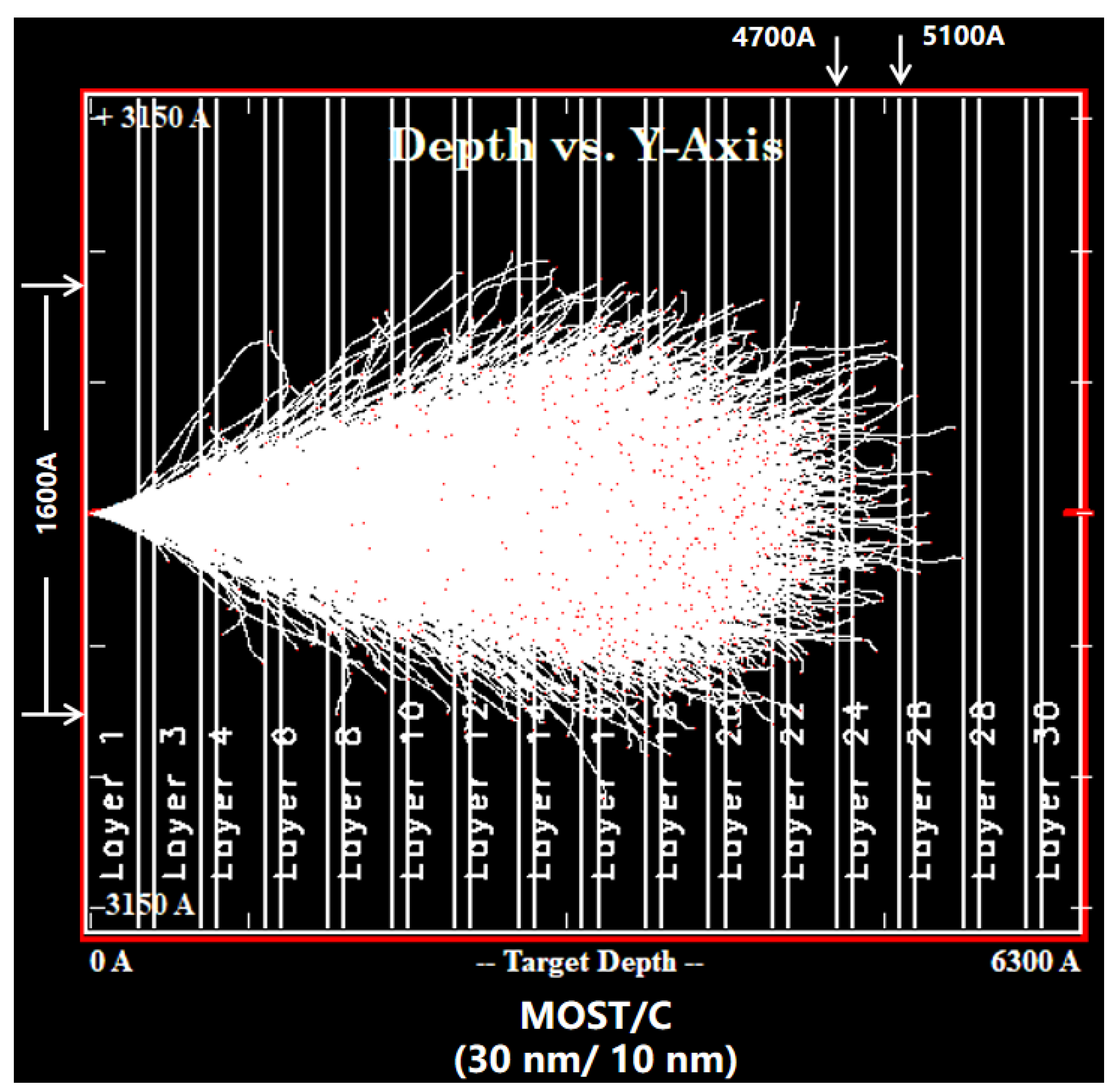
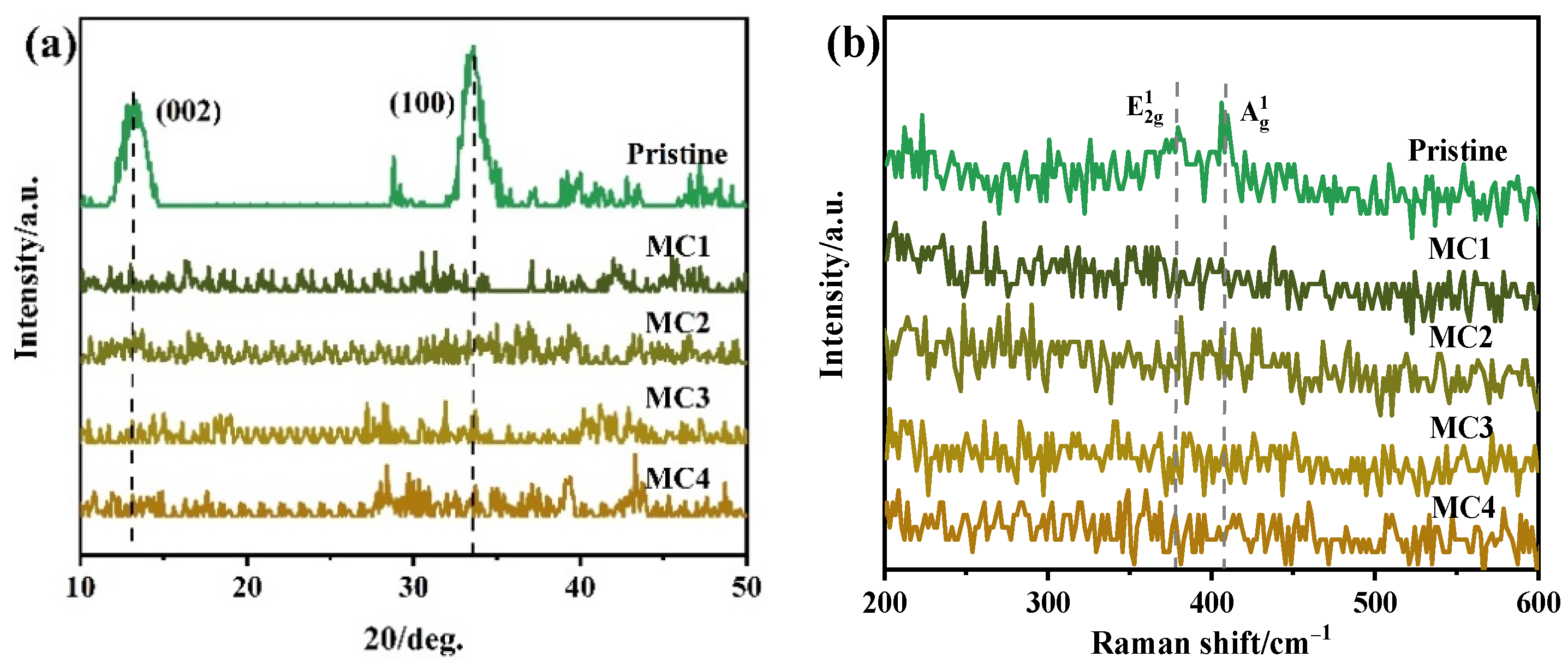
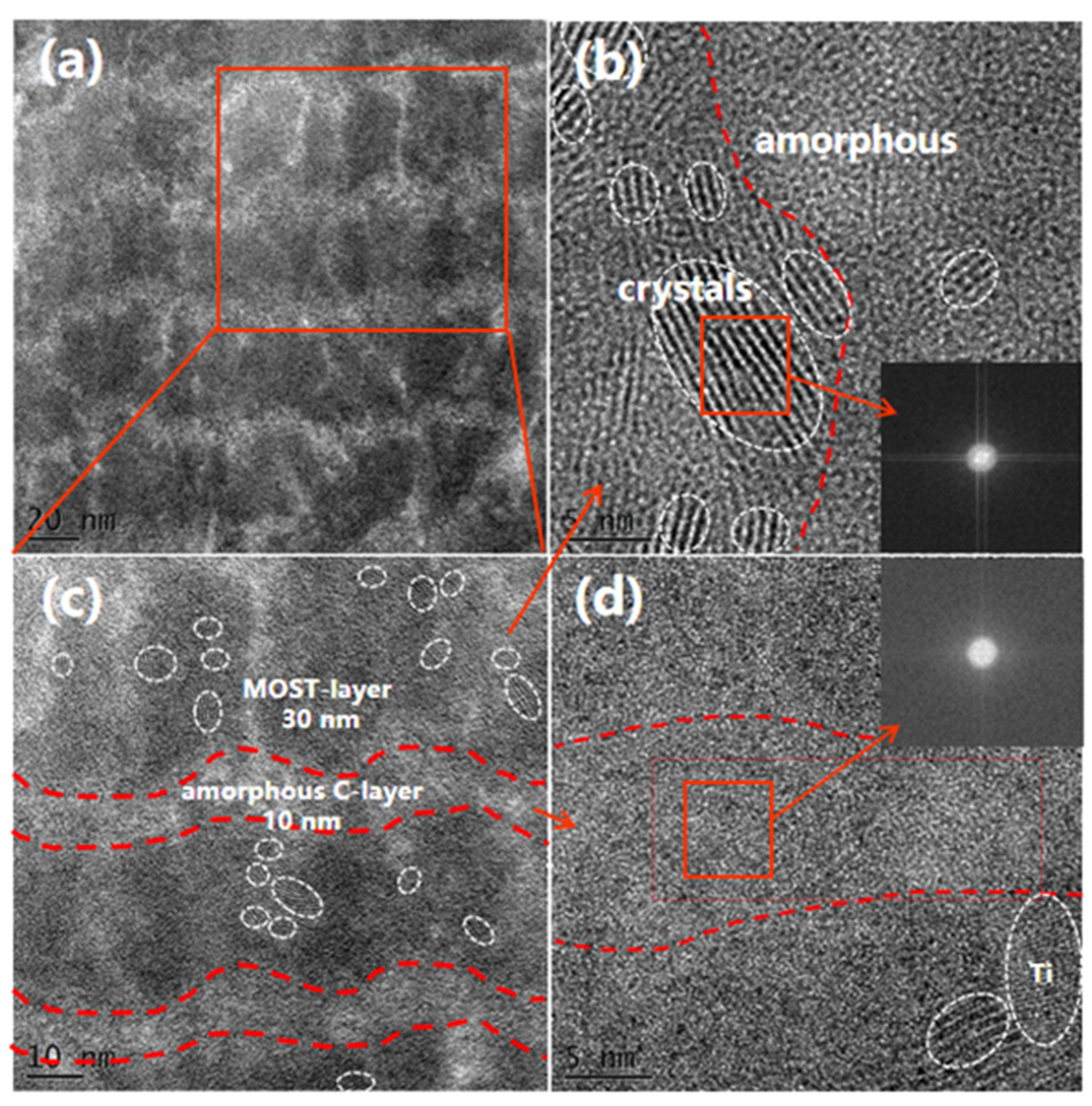

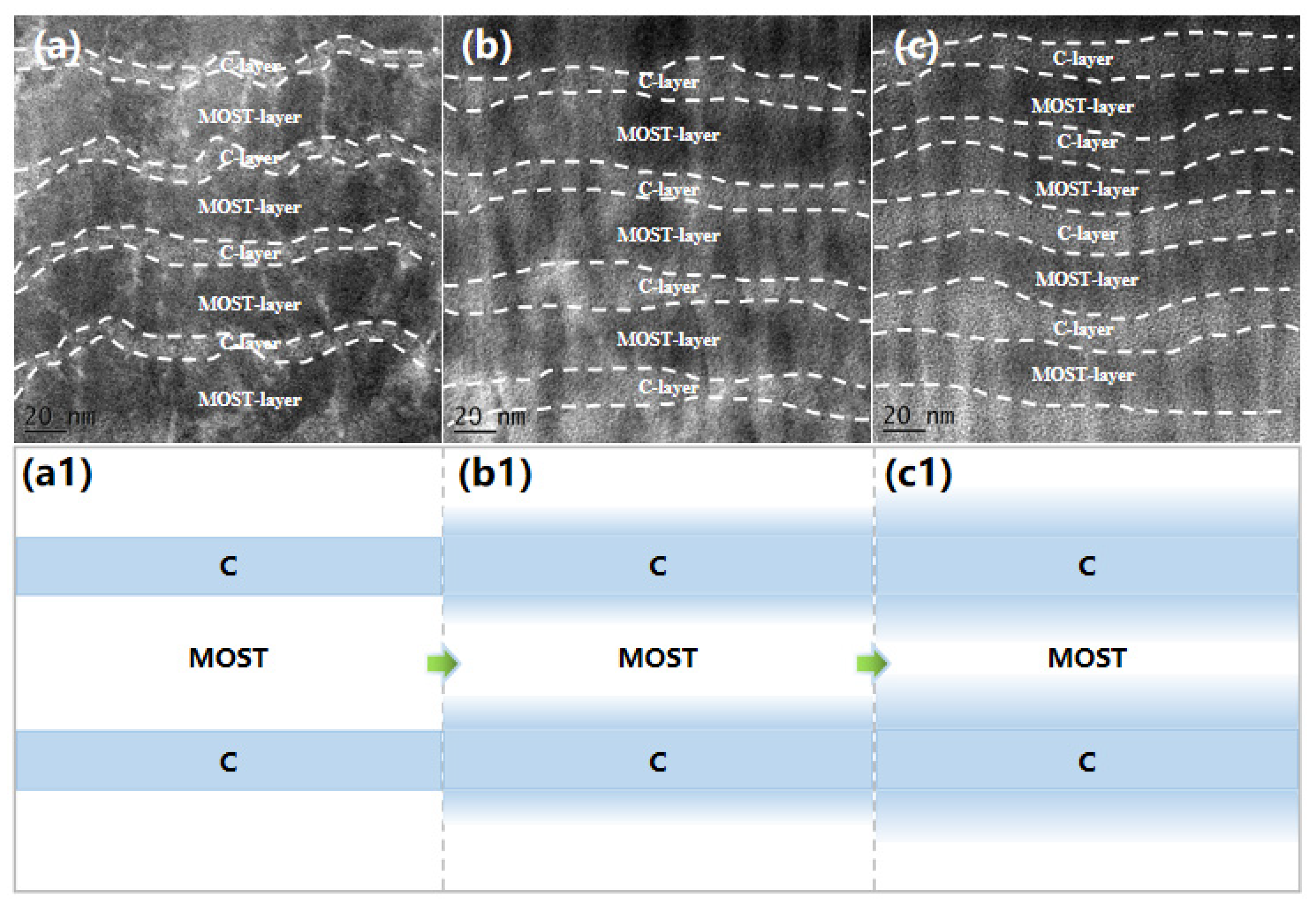
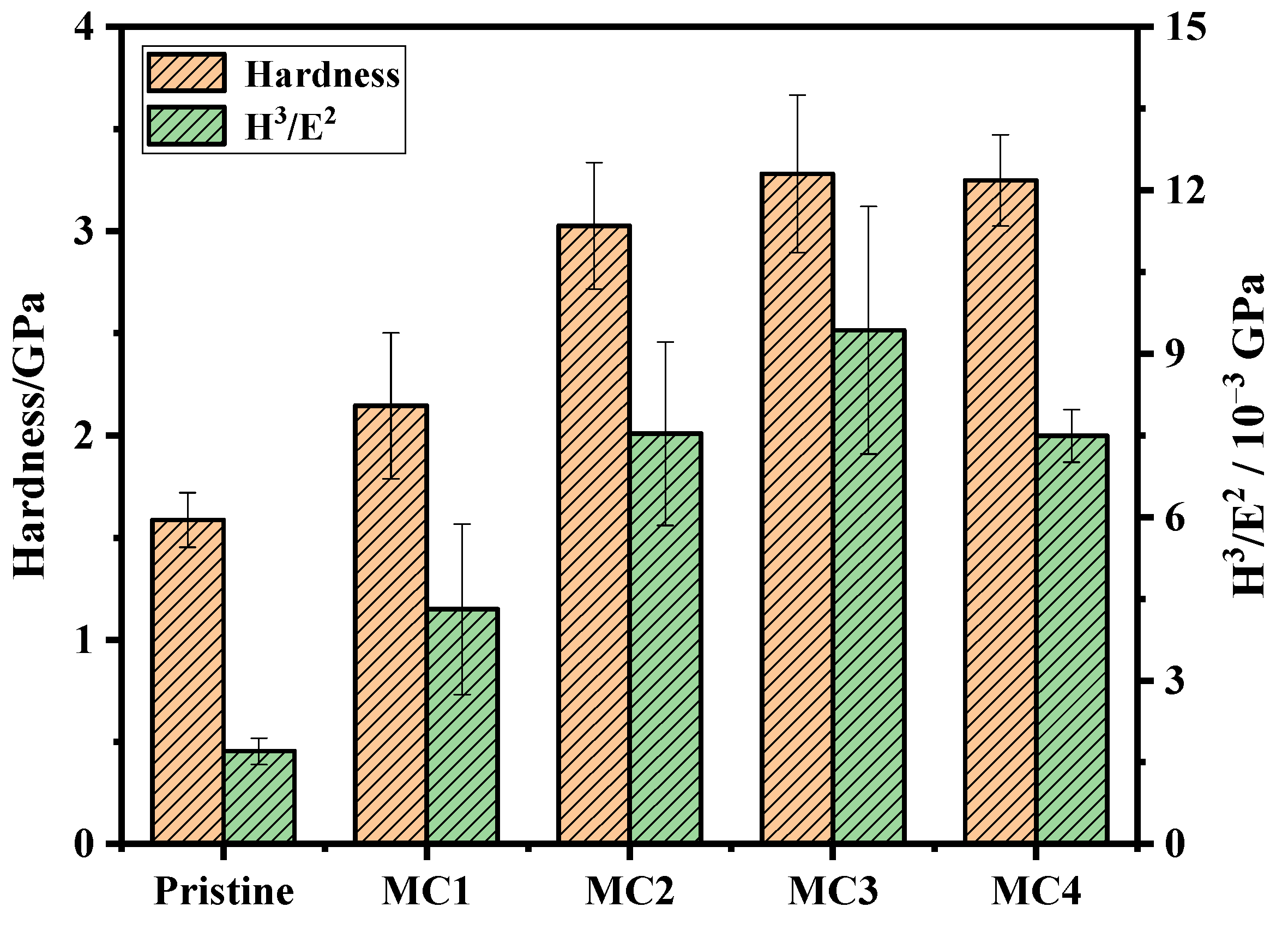
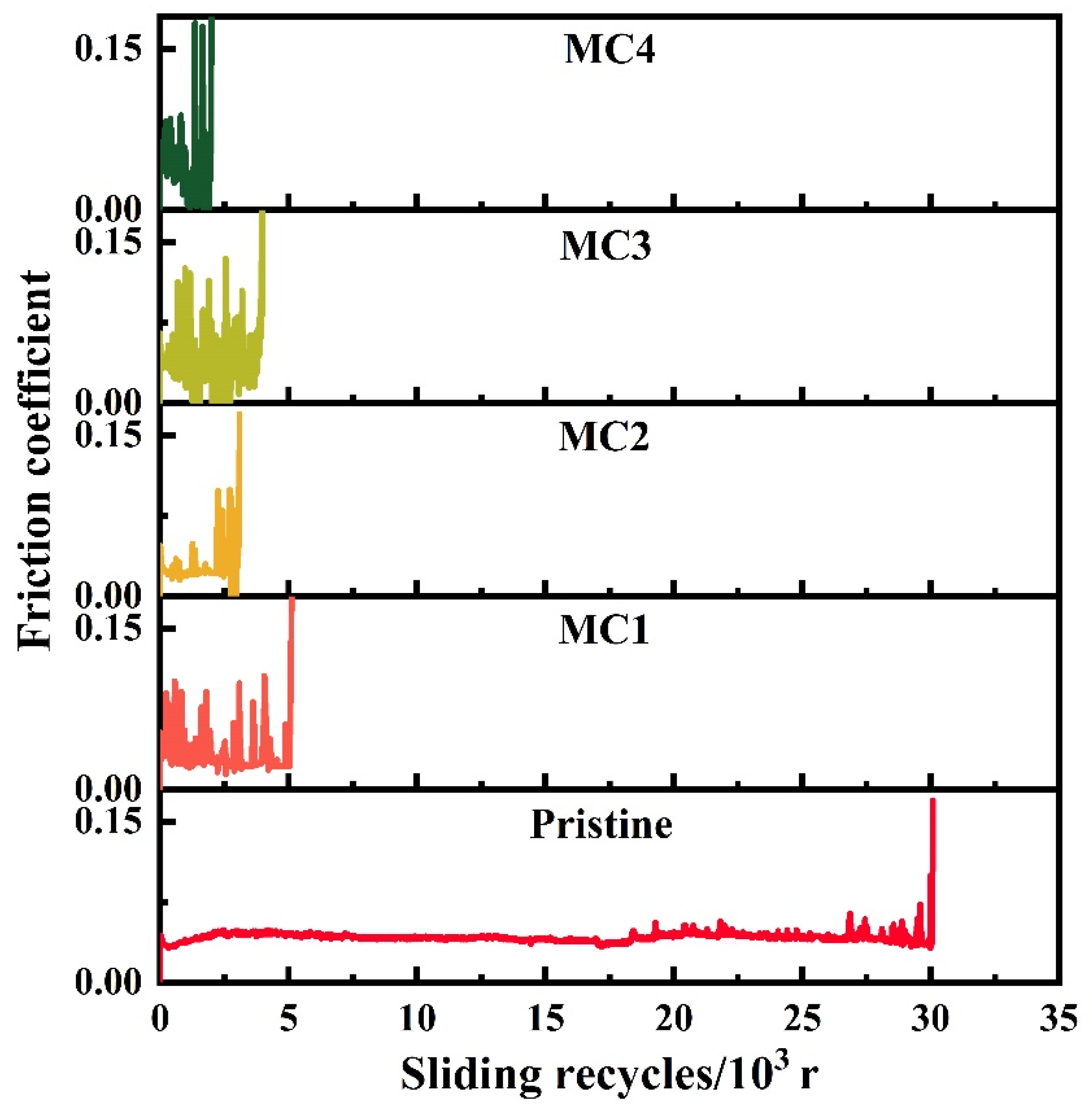
| Serial Number | Irradiation Dose (Ions/cm2) | Chemical Composition (at. %) | S/Mo | |||
|---|---|---|---|---|---|---|
| S | Mo | Ti | O | |||
| Pri | 0 | 52.28 | 26.32 | 5.86 | 15.54 | 1.98 |
| MC1 | 1.0 × 1014 | 50.59 | 25.95 | 5.39 | 18.07 | 1.95 |
| MC2 | 3.3 × 1014 | 50.56 | 26.00 | 5.43 | 18.01 | 1.94 |
| MC3 | 6.6 × 1014 | 50.65 | 26.99 | 5.74 | 16.62 | 1.88 |
| MC4 | 1.65 × 1015 | 51.25 | 30.82 | 5.93 | 12.00 | 1.66 |
Disclaimer/Publisher’s Note: The statements, opinions and data contained in all publications are solely those of the individual author(s) and contributor(s) and not of MDPI and/or the editor(s). MDPI and/or the editor(s) disclaim responsibility for any injury to people or property resulting from any ideas, methods, instructions or products referred to in the content. |
© 2023 by the authors. Licensee MDPI, Basel, Switzerland. This article is an open access article distributed under the terms and conditions of the Creative Commons Attribution (CC BY) license (https://creativecommons.org/licenses/by/4.0/).
Share and Cite
Zhang, R.; Zhang, H.; Qiao, L.; Wang, P. Damage Effects of Heavy Ion Irradiation on MOST/C Multilayer Films. Coatings 2023, 13, 176. https://doi.org/10.3390/coatings13010176
Zhang R, Zhang H, Qiao L, Wang P. Damage Effects of Heavy Ion Irradiation on MOST/C Multilayer Films. Coatings. 2023; 13(1):176. https://doi.org/10.3390/coatings13010176
Chicago/Turabian StyleZhang, Rui, Hong Zhang, Li Qiao, and Peng Wang. 2023. "Damage Effects of Heavy Ion Irradiation on MOST/C Multilayer Films" Coatings 13, no. 1: 176. https://doi.org/10.3390/coatings13010176




